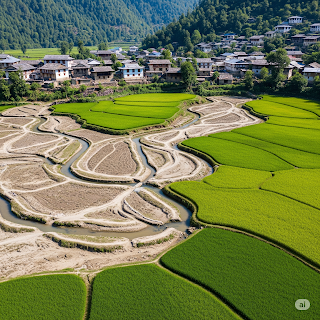Dry Paddy Fields: A Silent Crisis in Kashmir
In the heart of Kashmir, once lush paddy fields are now parched. Farmers look on helplessly as irrigation canals dry up, with Jhelum River water levels at a historic low.
Experts warn of a potential food security crisis if urgent changes aren’t adopted.
“This is no longer a seasonal issue—it’s a structural collapse,” says Dr. Taha Bukhari, agricultural economist at SKUAST-K.
🏞️ Why Is the Water Vanishing?
1. Glacial Retreat
Jhelum’s water flow depends on Himalayan glaciers. Warming temperatures have accelerated glacial melt, disrupting the seasonal water balance.
2. Inefficient Canal Systems
Aging irrigation infrastructure in Kashmir leaks or fails to deliver water to fields.
3. Early Heat Waves & Low Snowfall
2025 has seen 30% below-normal snowfall, and early spring heat has dried tributaries prematurely.
🔍 What Is the System of Rice Intensification (SRI)?
SRI is a low-water, high-yield method of rice cultivation that involves:
Planting young seedlings singly and widely spaced
Using minimal water (not flooding fields continuously)
Mechanically weeding to aerate soil
Using organic inputs
SRI can reduce water use by up to 40% and increase yields by 20–50%.
📊 How Has SRI Worked Elsewhere?
Tamil Nadu
Farmers in Trichy and Thanjavur shifted to SRI, saving water and increasing rice output during drought years.
Bihar
Women SHGs in Gaya district report 25% higher yields after switching to SRI practices.
Telangana
Government-led SRI promotion helped reduce tube well dependency, saving electricity subsidies.
📍 Kashmir: Ready or Resistant to SRI?
Barriers in Adoption:
Lack of awareness among farmers
High initial labor
Misconception that more water equals more rice
Opportunities:
SRI training through KVKs and agricultural universities
Youth-led digital farmer advisory platforms
Government incentive programs
“SRI could help us farm more with less—something we desperately need,” says Rehman Dar, a farmer in Pulwama.
🛠️ Other Water-Smart Practices Kashmir Needs
Drip irrigation for vegetable patches
Rainwater harvesting tanks for upland villages
Laser land levelling to reduce water run-off
Mulching and intercropping for soil moisture retention
🧭 What Can Policymakers Do?
Offer financial incentives for SRI adopters
Create micro-irrigation zones near dried canals
Launch mobile-based SRI advisories for remote farmers
Invest in canal renovation and glacial monitoring systems
“We need a Himalayan Agri-Resilience Mission urgently,” recommends Dr. Nasreen Kaul, water management specialist.
📉 Consequences of Inaction
Massive rice shortages by September harvest
Farmer debt spikes due to crop failure
Loss of rural jobs and migration to cities
Long-term soil degradation due to cracked, exposed fields
🌱 Final Thoughts: Modern Tools for an Ancient Crop
Kashmir’s rice is more than food—it's a symbol of heritage. To protect it, farmers must embrace smarter, sustainable farming techniques.
With targeted policy, tech-driven extension support, and urgent water system upgrades, Kashmir can prevent a full-blown agricultural crisis.


No comments:
Post a Comment